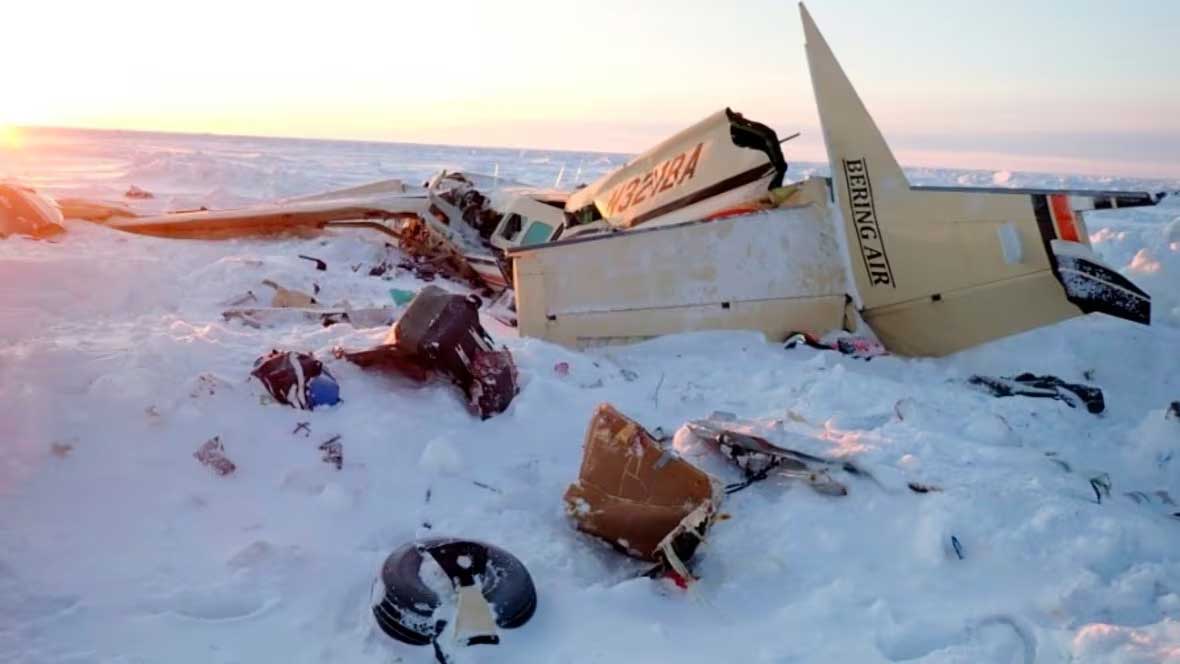The Bering Air commuter flight that tragically crashed into sea ice off the coast of Alaska, resulting in the deaths of all 10 people on board, was significantly overweight at the time of takeoff, according to the National Transportation Safety Board (NTSB). A new report by the NTSB confirms that the aircraft exceeded the maximum allowable weight limit by over 1,000 pounds, raising serious safety concerns.
The Textron Aviation 208B plane was en route from Unalakleet to Nome when it disappeared on February 6, 2024. Days later, the U.S. Coast Guard discovered its wreckage on sea ice approximately 30 miles southeast of Nome.
Key Findings of the NTSB Report
According to the preliminary NTSB report, the aircraft was operating well beyond its safe weight limits:
- The maximum takeoff gross weight for flights in known or forecast icing conditions was 8,807 pounds.
- The aircraft had an Aircraft Payload Extender III (APE III) system, which raised the maximum takeoff weight to 9,062 pounds.
- At the time of the accident, the plane’s estimated gross takeoff weight was 9,865 pounds— 1,058 pounds over the limit for icing conditions and 803 pounds over the limit for general flight operations.
Baggage and Cargo Contributed to Overloading
The investigation found that the plane’s baggage and cargo weighed approximately 798 pounds, contributing to the significant overloading of the aircraft.
Final Tracking Data Before the Crash
The last known satellite tracking data recorded the plane at an altitude of 200 feet at 3:20:17 PM, moments before the crash.
Aircraft’s Ice Protection System
The Textron Aviation 208B was equipped with a TKS ice protection system, designed to prevent the buildup of ice on key areas of the plane, including:
- Wings
- Horizontal and vertical stabilizers
- Wing struts
- Propeller and windshield
Despite these protective features, flying in icing conditions with excess weight could have significantly impacted the aircraft’s performance and handling.
Pilot Experience and FAA Regulations
The NTSB report also examined the pilot’s experience and qualifications:
- The pilot had approximately 2,500 hours of total flight experience.
- They had logged 1,060 hours in Textron Aviation 208B aircraft.
- FAA records confirmed the plane was approved for increased weight limits, but it still exceeded safety thresholds at takeoff.
Ongoing Investigation into Flight Performance
The NTSB has confirmed that a senior aerospace engineer will conduct a detailed review of the aircraft’s performance. This will include an evaluation of the plane’s center of gravity to determine if weight distribution contributed to the crash.
Victims of the Crash
Among the 10 victims were Rhone Baumgartner (46) and Kameron Hartvigson (41), who were traveling to Nome after working on a heat recovery system for the community’s water plant. The Alaska Native Tribal Health Consortium confirmed their involvement in infrastructure maintenance projects in Unalakleet before boarding the ill-fated flight.
Aviation Safety Concerns and Overloading Risks
Aircraft weight regulations exist to ensure safe flight operations, particularly in harsh weather conditions like those experienced in Alaska’s winter climate. Overloading an aircraft can lead to:
- Reduced lift and stability
- Longer takeoff distances
- Decreased climb performance
- Difficulty controlling the aircraft in adverse weather
With this incident, aviation experts emphasize the critical need for strict compliance with weight regulations, especially in regions prone to severe icing conditions.
Regulatory Response & Future Precautions
The FAA and NTSB may consider new guidelines or stricter enforcement measures to prevent similar incidents in the future. Airlines and operators in Alaska may face increased scrutiny over weight management practices and compliance with safety limits.
Conclusion
The Bering Air crash has highlighted serious safety concerns related to aircraft weight limits and flight operations in harsh winter conditions. With the plane exceeding weight limits by over 1,000 pounds, this tragedy serves as a stark reminder of the critical role of weight compliance in aviation safety.
As the NTSB continues its investigation, further insights may reveal more about the cause of the crash and potential preventative measures for future flights in extreme environments.
YAllA TV – www.yallatv.ae





